VI. Fin de séjour: Julietta
and Musical Symbolism
The
premiere of Martinů’s opera Julietta
at the National Theater in Prague in
March 1938 was one of the great triumphs
to take place during the composer’s
residence in Paris. In many ways Julietta
is the artistic culmination of all that
Martinů had strived for in Paris.
The surreal subject matter hearkens
back to unsuccessful theatrical experiments
of the twenties, when Martinů collaborated
with the Dadaist poet Georges Ribemont-Dessaignes
on the jazz operas Les
Larmes du couteau
and Les Trois souhaits. Neither
opera was staged during the composer’s
lifetime. Julietta demonstrates
a fusion of styles; the very act of
Martinů fashioning a Czech libretto
from the original play by French poet
George Neveux brings this idea to the
foreground. Here Martinů continued
the general trend of the recently completed
opera Divadlo za branou (Theatre
Behind the Gate), in which the mimed
style of Debureau and the characters
of the commedia dell’ arte were
transported to the Czech folk theater.
With Julietta, however, the musical
language proved entirely different from
its light-hearted operatic predecessor.
Although
clearly one of Martinů’s most complex
scores, Julietta
arguably contains only two distinct
types of music. The first type reflects
the psychological imbalance from which
all the characters suffer, from the
townspeople who muddle through absurd
lives without memories, to the tragic
figure of the visitor Michel who alone
possesses rationality but is in danger
of succumbing to this dream world. This
music darkly updates operatic buffo
conventions by employing thick, claustrophobic
orchestration, relentless rhythms and
dissonant harmonies recalling Stravinsky’s
so-called primitive style. Indeed, the
entire work begins with a nod to the
Rite of Spring as a frenzied
bassoon solo begins on an extremely
high B above middle C (not wanting to
outdo Stravinsky, who begins his Rite
a half-step higher). This rhythmic,
restless music frequently depicts the
villagers’ absurd situations, underlining
their desperate situations.
The second musical type
is the haunting "dream music"
associated with the title character,
Julietta. Here the opera’s twin idées
fixes of rationality versus desire
and reality versus dream are explored
in Martinů’s
most vulnerable, folk-inspired style.
Michel loves Julietta, but she does
not represent reality, cannot truly
be grasped, and since she does not possess
any memories she cannot love him in
return. Like the pastoral, this music
is destined to evaporate
just as a dream ceases to exist when
the protagonist awakens. At the end
of the opera Michel realizes that all
that has happened was indeed a dream,
but he is given a final opportunity
to choose between reality and fantasy,
with no turning back. For
Martinů these symbolic meanings
behind the opera acquired a deeply personal
significance that resonated uniquely
in the works that he was to compose
subsequent to the opera until his death
twenty years later.
The dream world of Julietta
is conjured by her unaccompanied love
song, the first music given to her character.
This is the song that has driven Michel
to return to the village to once again
seek her out. The opening three notes
attain such importance in the work that
henceforth they will be referred to
as the "Julietta motive".
They are initially joined to a fourth
note to set the words "Moje láska",
but Martinů
treats the first three notes as a separate
motive (perhaps representing a fragment,
or memory, of the original four?). It
is a simple descending figure, extremely
melancholy in character. At the end
of Julietta’s song the motive returns
in a Gypsy-like
transformation, ultimately giving the
tune an almost dangerous, exotic allure.
One is reminded of Janáček’s enticing
Gypsy woman who briefly sings in the
middle of his song cycle, The
Diary of One Who Vanished.
Here is Julietta’s song:


("My love is lost far away, over
the wide sea he’s gone tonight. With
the return
of the star up in the sky, may he come
back, may my love come back too!")
Complementing the Julietta
motive is a second symbolically related
gesture that has often been termed the
"Julietta chords". It is a
distinctive, uncannily memorable modified
plagal cadence, and again there is a
connection to Janáček, who used
the progression to stirring effect in
the finale of his Taras
Bulba. In the
case of Julietta, it seems to represent
an onrush of emotion, a heady combination
of longing and romantic desire. In its
initial appearance, the orchestra (piano
reduction) loudly proclaims the chords
just as Julietta enters the stage for
the first time:
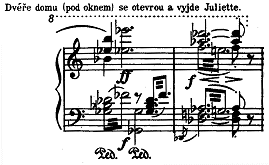
Both ideas occur throughout
the opera, often in crucial dramatic
moments, reflecting the allure of this
dream world as well as its dark side.
In Act 2, scene 5, when Michel and Julietta
at last find themselves alone together,
the Julietta motive appears warmly in
the orchestra, apparently reflecting
the couple’s happiness. But as Julietta
sings "But now I’ve got you here!
In my arms! (Captive, and we are alone,
just the two of us!)", several
dissonant harmonizations of the motive
seem to reflect the strangeness of this
surreal place and anticipate the tragic
trajectory of the opera. Michel, in
Julietta’s clutches, is in danger of
becoming a prisoner of her world without
real memories, but he is not yet aware
of it. The passage also underlines the
freedom with which Martinů
treats this descending motive throughout
the opera; here the falling three notes
are no longer stepwise, but are expressed
in a variety of intervallic configurations:

The motive also appears memorably in
a scene with minor characters. An older
couple is buying memories from a souvenir
vendor (literally), who invents interesting
details of a past they cannot remember.
They are overjoyed at receiving these,
even if they question the authenticity
of the seller’s wares ("Are you
quite sure the dress was white?"
asks the grandmother. "Quite sure!"
is the vendor’s confident reply). The
motive once again appears stepwise in
this scene (accompanied by piano solo),
and also in inversion. This is in clear
folk style, perhaps reflecting the hopeless
naïveté of the couple, but
also containing an emotional poignancy,
gaining the audience’s sympathy for
the couple’s predicament:
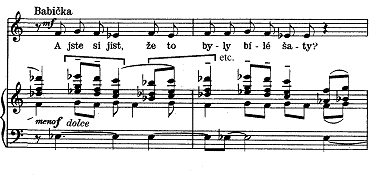
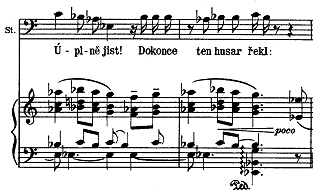
Another symbolically important appearance
of the Julietta motive occurs at the
end of the opera, where Michel sees
a frightening vision of other men who
never woke up from their dreams and
have been lost forever to reality. As
they disappear behind a closing door
to the dream world, the motive is heard
chromatically descending, underscoring
the fate of these hapless souls who
are now dead to reality:

As the climax of the opera approaches,
Michel must choose between worlds once
and for all, but cannot seem to make
up his mind. The Julietta chords return
in tandem with the descending motive
as Michel laments, "I am afraid…that
as soon as I leave I will forget it
all! And I do not want to forget!"
These words demonstrate the irony upon
which the entire opera is based. Michel’s
very existence is defined by his memories,
yet he is moved to sacrifice them in
order to join Julietta in her world.
He loses in either case, because Julietta
is not real and he cannot grasp her
in dreams any more than in reality.
Thus, with the appearance of the Julietta
chords in this passage the link to Michel’s
desire for her is made clear:
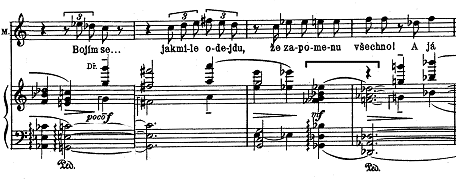
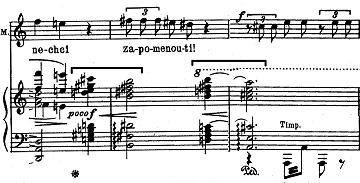
If
Martinů’s use of the so-called
Julietta chords appears for the first
time in this work, the three-note descending
Julietta motive was long a favorite
melodic gesture in Martinů’s works.
Before Julietta,
there are several characteristic passages
that seem to foreshadow
similar use of the motive in the opera.
Martinů appears to have extracted
the Julietta motive from a simple melodic
gesture common in Czech folk songs.
Martinů arranged one such song
in a set of children’s pieces for piano,
entitled Božánkovi a Sonničce
(Božánek and Sonička), written
in 1932. The folk song used by Martinů
is “Ještĕ já se podivam” (Now I’ll
Take a Look). The setting is as simple
as possible, reflecting the work’s young
dedicatees. Here the descending pattern
appears as a cadential gesture,
as is frequently the case in Julietta:
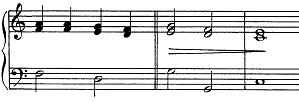
From the early Parisian ballet Vzpoura
(The Revolt) discussed at length in
chapter three, a stylized folk tune
resembling the previous example features
an equally prominent use of the Julietta
motive. In the scenario to the ballet,
this is the melody that brings the notes
back from their general strike and saves
the day. The tune, written down by the
composer with the help of Inspiration
and a singing girl in national costume,
features the Julietta motive as the
most prominent melodic feature:

Another clearly folk-inspired example
of the Julietta motive occurs at the
beginning of the first of Quatre
mouvements for piano. The folk style
is evident with the abundant thirds
and sixths, and here, as in Julietta,
the descent is not exclusively stepwise:
More fervently expressive is the following
example from the finale of the String
Sextet, where the mostly stepwise melody
takes on a larger-than-life quality
reminiscent of the "crowd"
tunes from Half-time and La
Bagarre:

The more chromatic treatment
of the motive seen in Julietta
also has its antecedents in other Martinů
works, as the following example from
the String Quartet
with Orchestra
(1931) demonstrates. The pattern repeats
continuously in a gradual crescendo,
reaching a climax where it is heard
in augmentation, chromatically descending:
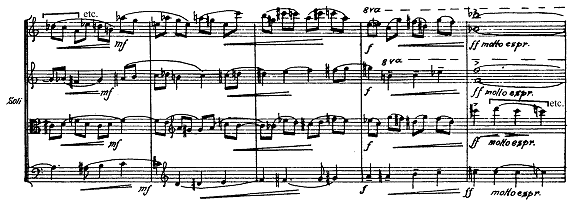
Finally, smaller works just prior to
Julietta show the composer experimenting
with the expressive possibilities of
the Julietta motive. Two dumky
for piano solo are significant in this
regard. The use of the title indicates
the melancholy association the composer
seems to have had with the motive at
the time the opera was in gestation,
as well as his apparent fondness for
its expressive simplicity. The two dumky
are in fact quite similar to each other;
even the final chords are identical
in pitch content. In the two examples
below (Dumka No.1 followed by
Dumka No. 2), the Julietta motive
is quite evident:


A third striking example from this
period is the following passage from
the Lístek do památníku
(Album Leaf) for piano, composed only
a year before the opera:

The stylistic congruence
between Julietta
and earlier Martinů works exemplified
by the presence of the Julietta motive
still hardly accounts for its near obsessive
usage in the wake of the opera’s completion
and first performance. The gesture apparently
becomes codified and assumes a personal
significance
for the composer, becoming a mannerism
that inhabits the bulk of Martinů’s
music written in America. The explanation
lies at least partly in Martinů’s
relationship with his pupil Vítĕzslava
Kaprálová, who arrived in Paris to study
composition with
him in October 1937.
Despite the fact that she was half his
age they fell in love and experienced
a very intense affair. Just after their
first lessons together Martinů
began work on his Concerto Grosso, which
features the Julietta motive in the
first movement
combined with Svatý Václave
(the five-note figure from version I
- see chapter four). This is the only
cantabile melody in the movement, and
the espressivo indication is
also telling:


It
is possible that Martinů was already
beginning to associate
the Julietta motive with his personal
feelings for Kaprálová
as early as the time of the Concerto
Grosso’s composition, but the connection
becomes more apparent in the following
year with the Tre ricercari.
Martinů and Kaprálová worked on
them together,
and meanwhile preparations were being
made for the premiere of Julietta
in Prague. Alongside the numerous symbolic
quotations of Svatý Václave
in this work mentioned in chapter four,
the Julietta motive also appears with
particular potency, and seems to reflect
the blossoming romance between teacher
and pupil. In the first movement the
Julietta motive appears significantly
at the first sign of an espressivo
marking, rather chromatic and rhythmically
chaotic:

In the second movement,
however, it
occurs in the guise of a pastoral. The
following passage is essentially a bucolic
love duet between the flute and oboe,
and it is possible to imagine one representing
Martinů and the other Kaprálová.
It extends to four descending notes
but the kinship with
the Julietta motive is nevertheless
clear. As if to underscore its importance,
the passage occurs three times during
the movement, extremely unusual for
Martinů in this type of continuously
developing neo-baroque work:

Later in the movement the reference
to the Julietta motive is even more
explicit, and again the instrumentation
(two pianos this time) seems symbolic.
The passage, with numerous repetitions
of the Julietta motive harmonized in
sixths, is purely transitional, a moment
of absolute repose which shimmers rapturously:
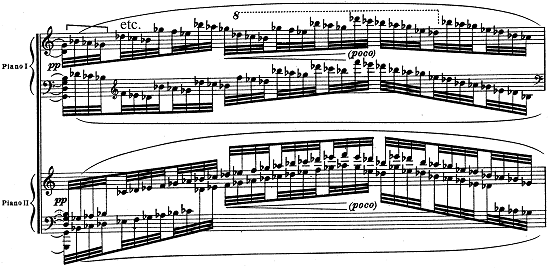
After the Ricercari
were completed, Kaprálová
began composing works that also included
the Julietta motive, as if the motive
had become a musical code for their
mutual affection. She produced her own
setting of the amorous
text Martinů had used in his recently
completed “Love Carol”, which itself
is full of references to the Julietta
motive. Here is the conclusion of Martinů’s
vocal part:
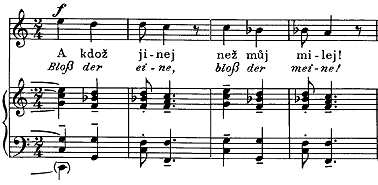
("And who else, but my love!")
In Kaprálová’s
version, she deliberately quotes a
portion of the Martinů that includes
the Julietta motive. In her re-harmonization
of the same melody, she is less explicit
in outlining the Julietta motive in
the piano chords while the voice rests,
but the reminiscence in any case remains
in the vocal part
itself. Here is the Martinů version,
followed by Kaprálová’s parody: 
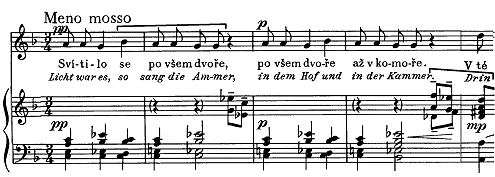
Two other works composed
by Kaprálová during this
same period include the Variations
sur le carillon de l’eglise Saint-Etienne-du-Mont
and the Partita for piano and string
orchestra. In the former work for piano
solo, the theme is derived from the
chimes of a church not far from Kaprálová’s
flat in Paris at the time, and the bells
could be heard outside the window of
the apartment. By coincidence the pattern
of chimes quite obviously resembled
the Julietta motive, a fact that must
have amused Martinů
and Kaprálová. Here is the brief theme:

Kaprálová’s
Partita, composed exactly at the time
of Julietta’s triumphant premiere,
also features the Julietta motive prominently.
Their appearances stand out conspicuously
from the otherwise impersonal neo-baroque
language modeled after her teacher.
In the first excerpt the treatment is
more melodic, but also displays another
characteristic apparently borrowed from
Martinů - secondary ragtime. In
the second example percussive patterns
of the Julietta motive
in the piano contrast with a more legato
version in the first violins:

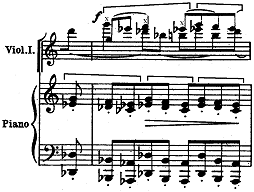
The
relationship between Martinů and
Kaprálová experienced many difficulties.
Like that between Julietta and Michel,
its unreality flew in the face of logic.
Martinů was reluctant
to leave his wife Charlotte, and there
was a limit to Kaprálová’s
patience with her married lover. Furthermore
the age gap, while not insurmountable,
was certainly a factor. A crisis ensued,
and Kaprálova left on an extended
holiday with another potential
suitor. When Martinů composed the
String Quartet No. 5 at this time, the
personal anguish he was apparently experiencing
found its way into the piece. Indeed,
he even dedicated a sketch of the work
to Kaprálová, in which numerous drawings
and annotations
dramatize the painful situation.
Not surprisingly, the Julietta motive
emerges in the work in extremely marked
contexts. It proves instructive to sample
each movement for characteristic occurrences.
In the first movement it appears in
secondary ragtime with a familiar oscillating
blues inflection. Against this unsettled
texture (featuring a second overlapping
ostinato), the viola expresses the Julietta
motive in long notes:
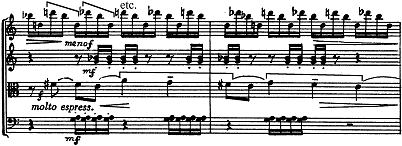
Another agitated appearance can be
seen in the second movement, an equally
familiar chromatically descending figure:
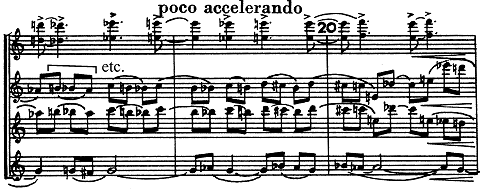
In the scherzo the motive acts as an
accompaniment in a grotesque danse
macabre as pessimism continues to
dominate:
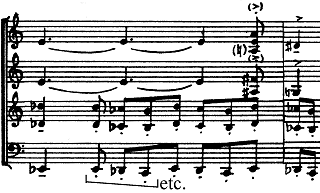
Only in the finale does the Julietta
motive finally emerge as the principal
material, after which it undergoes a
series of fascinating transformations.
The melancholy tune in the first violin
is obviously based upon it:

The return of a chromatically descending
version adds to the desolate character,
and the melody is altered to no longer
explicitly outline the Julietta motive:

The three chromatically descending
notes then develop into a lugubrious
four-note ostinato that is not entirely
regular:

Another additive technique is featured
in this movement as the Julietta motive
is extended by chromatic increments
from its original three-note cell:


In the last measures of the quartet
the Julietta motive leads to desperate,
anguished chords, while the chromatically
descending pattern can be seen one last
time in the cello part in the penultimate
bar:
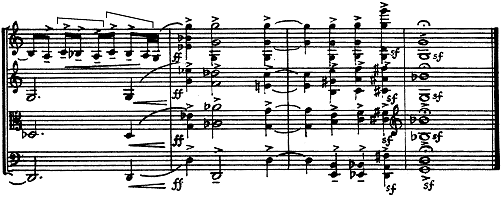
The
use of the Julietta motive to reflect
anger and despair is more balanced with
lyrical tendencies in Martinů’s
next work, the Concertino for piano
and orchestra. There are still grotesque
permutations of the Julietta motive,
as for example in the
climax of the first movement:
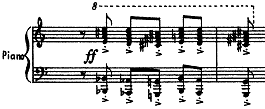
But Martinů also introduces the
Julietta motive as an absolutely characteristic
syncopated tune with the familiar L-S-L
pattern:

This returns in the finale as a cyclic
gesture:

These lyrical passages
show a more relaxed
approach to the motive, and seem to
reflect the fact that Martinů’s
relationship with Kaprálová had regained
some stability. Another conciliatory
gesture is found the slow movement of
this work, where Martinů seems
to be loosely quoting the third variation
from Kaprálová’s Variations
sur le carillon. If deliberate,
it is a touching example of reciprocal
inspiration, from pupil to composer.
Here is an excerpt from Kaprálová’s
variation, followed by the slow movement
of the Concertino:
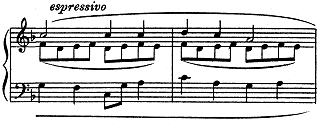
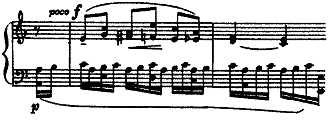
The piano work Fenêtre
sur le jardin, written
in the summer of 1938 by Martinů
while waiting for Kaprálová to return
to Paris from her home in Moravia, also
features the Julietta motive. But there
is no need to exhaustively detail each
occurrence, despite the motive’s obvious
symbolic importance.
Two examples from the Double Concerto
will suffice to close this section of
the discussion. In addition to the dramatic
use of Svatý Václave
in this work, the Julietta motive
also appears to gain a universally expressive
potency in this setting. It appears
in the following disturbing passage
form the first movement. As the polyphonic
strands pursue their individual courses,
the resulting vertical sonorities are
excruciating in their dissonance:

The Julietta motive emerges transformed
in the left hand of the piano solo featured
in the Largo. Now the motive
is inverted, taking on the shape of
a chromatically ascending three-note
figure. This is the motive that returns
urgently at the end of the finale. Here,
it accompanies a lugubrious melody where
the original Julietta motive is prominent
as well:

In
January of 1939, several months after
completing the Double Concerto, Martinů
gave Kaprálová a piano sketch of Julietta,
confirming the composer’s perceived
connection between his pupil and the
title character of his opera. The sketch
is touchingly inscribed
with reminiscences of experiences the
two shared. As Martinů wrote later
to Kaprálová, these memories no longer
seemed real in the wake of the horrors
of war.
It is not surprising
that as a musical symbol the Julietta
motive seems to become increasingly
tied to the upheaval caused by world
events. Kaprálová eventually married
Jiří Mucha, son of the painter
Alfons Mucha, who had collaborated with
Martinů on the text of his Field
Mass. But composer
and pupil remained very close even so,
and Martinů
was devastated by her sudden death from
tubersulosis in June of 1940 at the
age of 25. At the same time he and Charlotte
had barely escaped the Nazis, fleeing
Paris for the south of France only days
before the Germans occupied the city.
In these dire circumstances,
while waiting for exit visas and the
promise of a new life in America, Martinů
composed the Fantasy
and Toccata
for Czech pianist Rudolf Firkušný, who
had recently broken the news to Martinů
of Kaprálová’s death. Firkušný’s connection
to Julietta was significant, for he
had attended the premiere in Prague
and knew how much the opera meant to
Martinů.
The Fantasy and Toccata
is Martinů’s first composition
after Kaprálová’s death, and the music
does not hide the fact. In the first
bars the Julietta
chords are wedded to the Julietta motive
(descending B-F#-E) in a single, obviously
symbolic gesture:
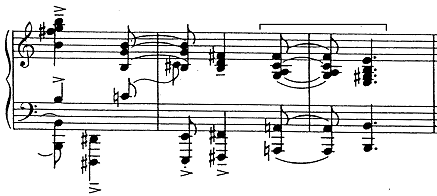
Later in the Fantasy movement
the Julietta motive is featured as a
lyrical oasis amidst much dissonant
writing. The excerpt below is typical,
as it begins vulnerably but soon increases
in intensity until, in subsequent measures,
the lyrical element (and the Julietta
motive) disintegrates. Both hands feature
the motive, with the left hand in diminution:

When
Martinů finally arrived safely
in America on March 31, 1941, the ghost
of Julietta (and, presumably, Kaprálová)
continued to haunt him. The score to
his beloved opera lay hidden somewhere
in Europe and like so many of his scores
it would be inaccessible
until after the end of the war. When
the composer was asked to write an homage
to Paderewski who had recently died,
he responded with a Mazurka. But this
piece, Martinů’s first to be written
in America, is inhabited by Czech, not
Polish, ghosts. The
Julietta motive appears in mazurka rhythm,
accompanied by the related, rising three-note
chromatic figure from the Double Concerto
in the left hand:

In the Concerto da Camera for
violin, piano, timpani and strings,
composed soon afterward, the Julietta
motive is heard very conspicuously in
a powerfully symbolic passage. The orchestra
here is all octatonic, with various
overlapping ostinati, except for the
double bass, which disagrees (see circled
notes). Later the second violins also
depart from the octatonic scale in order
to play the Julietta motive chromatically.
All of this creates a tonally muddy
effect in a very uncharacteristic passage
of noisy chaos. From this utter breakdown
of musical coherence the Julietta motive
emerges in the solo violin, in minor
mode - just as it initially appeared
in the opera, but now repeated almost
endlessly:
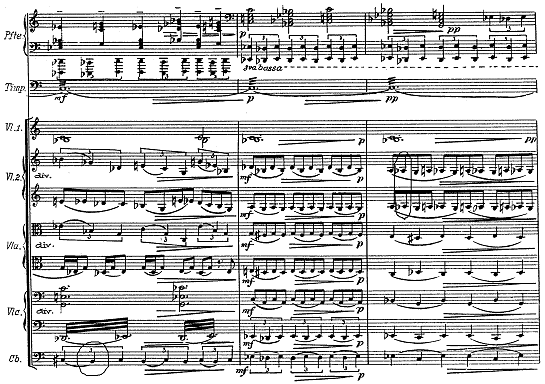
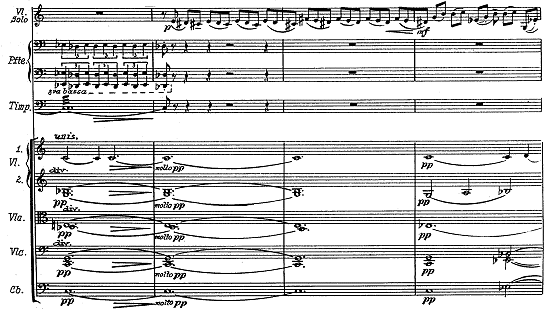
This ray of optimism, seeming to rise
out of the ashes in the excerpt above,
shines much brighter in the finale,
where the Julietta motive is transformed
into a cheerful, syncopated dance tune:
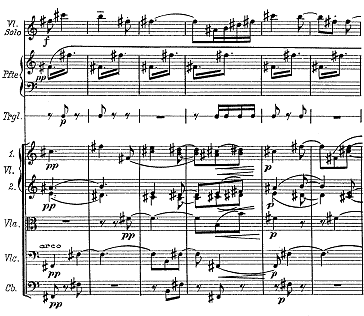
Another memorable use of the Julietta
motive in an early American work occurs
in the somber slow movement of the Piano
Quartet. Here, polyphony in the string
trio (piano reduction) is evident but
somewhat minimized by parallel descending
motion and mostly triadic vertical formulations:
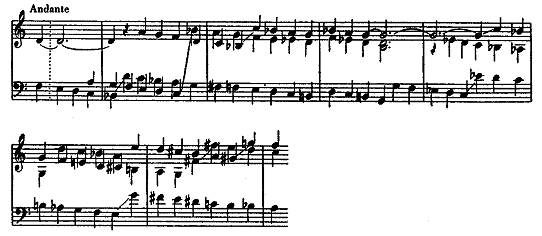
Finally,
Martinů wrote a third Dumka
for piano during this period, recalling
the two works composed alongside Julietta
in Paris. Of the three this is the most
moving, with the Julietta chords appearing
alongside the Julietta motive in a very
bittersweet musical remembrance:
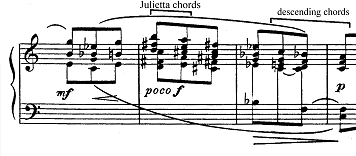
If
all of the evidence cited above is not
conclusive proof of Martinů’s symbolic
association of the Julietta motive with
Kaprálová and the life-changing events
that brought an end to his years in
Paris, one last work should settle the
question. This is the Adagio
for piano written in 1957 in memory
of Kaprálova and her father Václav Kaprál.
1957 was the tenth anniversary of Kaprál’s
death, and Kaprálová’s mother asked
Martinů to write a piece in memory
of her daughter and husband, especially
recalling the summer of 1938 which they
all spent together at the Kaprál’s residence
at Tři Studnĕ. After this
idyllic holiday Martinů never again
set foot in his native country.
The Adagio begins with the Julietta
motive in the left hand, descending
chromatically, a clear metaphor of death
and loss and the same variant originally
used to depict the lost souls in Julietta:
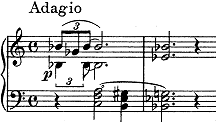
After a dramatic arrival on G minor
recalling the composer’s Memorial
to Lidice, the Julietta motive rings
out in major, but no less painfully.
It is a desperate and lonely gesture,
surrounded by rests:
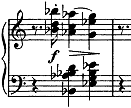
The Julietta motive continues to dominate
the musical material of this one-page
work, and is notably transformed in
a tender, almost pastoral passage, once
again appearing cadentially:
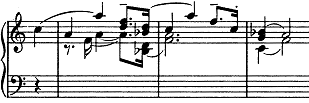
The sense of tragedy proves inescapable,
however, and the motive returns in its
chromatic guise to close the work.
As musical symbols the
Julietta chords and the Julietta motive,
alongside Svatý Václave,
are essential aspects to Martinů’s
music and as such demand our attention
and contemplation. The myriad cross-references
and connections that resonate within
the composer’s oeuvre build a more complete
picture of his aesthetic, and help to
explain why his music sounds the way
it does. Thus, when a listener hears
these musical trademarks in the first
violins at the beginning of the First
Symphony and recognizes its symbolic
significance, the listening experience
is that much more enriched:

When a variant of the above melody
returns in the finale to cap the entire
symphony, the symbols are able to resonate
specifically, and emotionally, within
the listener:

For
Martinů such passages could be
seen to represent, as the baritone soloist
declares at the conclusion of The
Opening of the Wells,
"the keys to home":
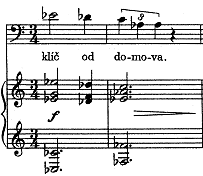
Introduction
I.
A New Beginning: Life In Paris
II.
How Martinů "Got Rhythm"
III.
Of Folk Tunes, Pastorals, and the Masses
IV.
Dvakrát Svatý Václave
(St. Wenceslas, Twice)
V.
An Aspect of Minor/Major Significance
VI.
Fin de séjour: Julietta
and Musical Symbolism
VII.Conclusion:
Martinů’s Parisian Legacy

